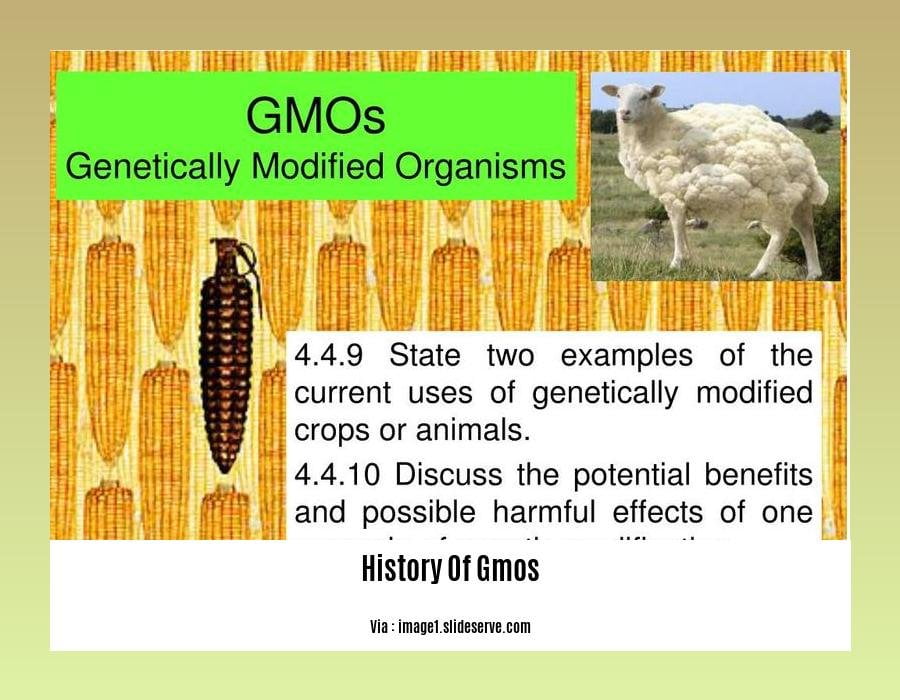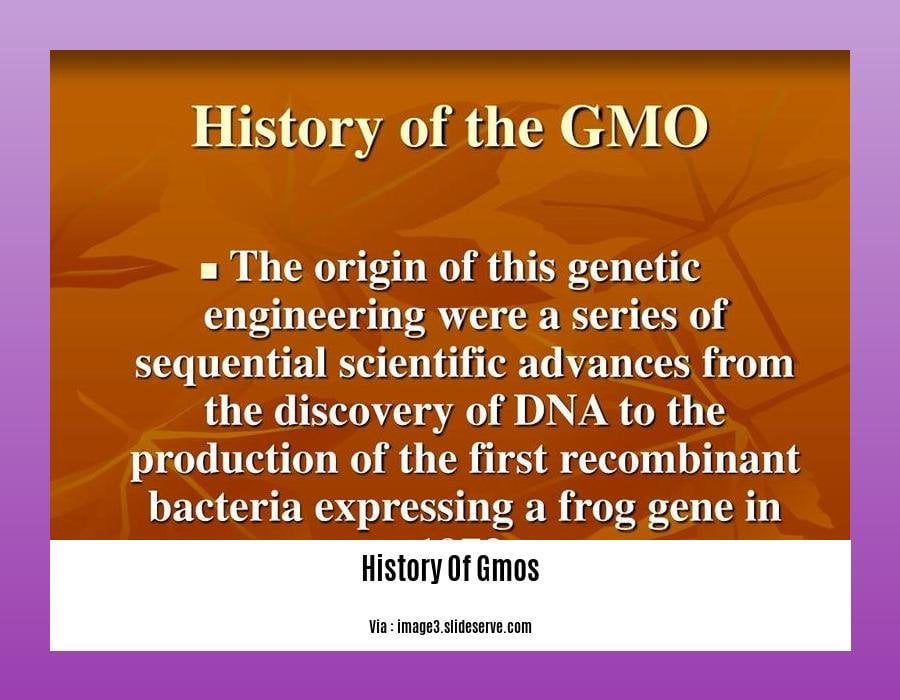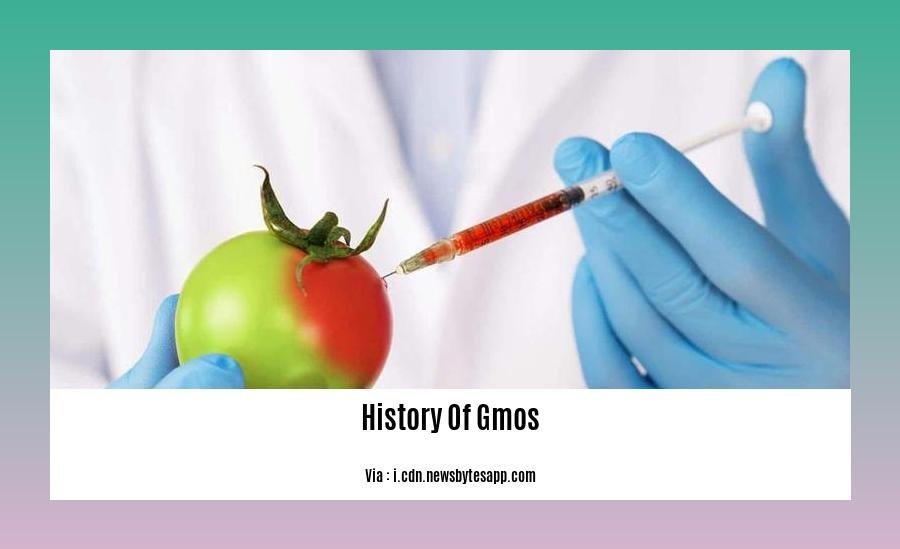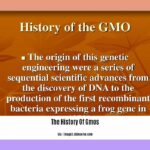Embark on a captivating journey through the annals of history as we trace the evolution of genetically modified organisms (GMOs) in our comprehensive article, [- Tracing the Evolution of Genetically Modified Organisms: A Comprehensive History of GMOs]. From their humble beginnings to their current applications and the controversies they have sparked, we delve into the world of GMOs to unravel their intricate history.
Key Takeaways:
-
Humans have been modifying organisms for centuries, using breeding methods to pass on desirable traits.
-
Genetic engineering, developed in the 20th century, allows for faster and more precise modification of organisms by altering their DNA.
-
Timeline of GMO developments:
-
1973: First recombinant DNA molecule created.
-
1982: First GMO food (bacterium producing insulin) approved by the FDA.
-
1994: First GMO crop (tomato that delays ripening) approved by the FDA.
-
1996: First GMO crops with herbicide and insect resistance commercially planted.
-
2015: First GMO animal (salmon that grows faster) approved by the FDA.
-
For more information, visit:
-
National Geographic: Genetically Modified Organisms
-
FDA: A Timeline of Genetic Modification in Modern Agriculture
A Historical Exploration of Genetically Modified Organisms (GMOs)

Genetically modified organisms (GMOs) have transformed the agricultural landscape and sparked scientific advancements with far-reaching implications. Their history is a captivating narrative of scientific breakthroughs, controversies, and societal debates. Let’s delve into the remarkable journey of GMOs, tracing their evolution from humble beginnings to their current prominence.
The Dawn of Genetic Modification
The history of GMOs can be traced back to the dawn of agriculture, where humans used selective breeding methods to modify plants and animals for desirable traits. However, the advent of genetic engineering in the 20th century revolutionized the field of genetic modification, allowing scientists to make precise changes to an organism’s DNA.
Early Achievements in Genetic Engineering
The first major breakthrough in genetic engineering occurred in 1973 when scientists successfully created the first recombinant DNA molecule. This discovery opened up new avenues for modifying organisms by introducing foreign genes into their DNA.
In 1982, the U.S. Food and Drug Administration (FDA) approved the first GMO food product – a bacterium engineered to produce insulin, a vital hormone for diabetics. This marked a significant milestone in the development of GMOs.
The Rise of Genetically Modified Crops
The 1990s witnessed the commercialization of genetically modified crops, starting with the FDA’s approval of the Flavr Savr tomato in 1994. This tomato was engineered to delay ripening, extending its shelf life.
Shortly after, in 1996, genetically modified crops with resistance to herbicides and insects were introduced, revolutionizing agricultural practices by reducing the need for chemical pesticides and herbicides.
Expanding Applications of GMOs
The applications of GMOs have expanded beyond agriculture into various fields, including medicine, biofuels, and industrial processes. Scientists are exploring the potential of GMOs to develop new vaccines, treatments for diseases, and sustainable energy sources.
Controversies and Ethical Considerations
The rapid advancement of GMOs has also sparked controversies and ethical debates. Concerns have been raised regarding the potential environmental impact of GMOs, the safety of consuming genetically modified foods, and the patenting of genetically modified organisms.
Regulatory bodies worldwide have implemented strict guidelines and approval processes to ensure the safety of GMOs before they can be released into the market.
Looking Ahead: The Future of Genetically Modified Organisms
As we move forward, the history of GMOs continues to be written. Scientists are constantly exploring new possibilities for using GMOs to address global challenges such as food security, climate change, and disease outbreaks.
The future of GMOs holds immense promise for shaping a more sustainable and prosperous world. With ongoing research and responsible regulation, we can harness the transformative power of GMOs to benefit humanity and the planet.
Read all about the intriguing journey of genetically modified organisms (GMOs) from their inception to their introduction into our food supply. Discover why these foods were created, the timeline of their introduction, and the specific details of the first GMO created. The History Of Gmos
Uncover the fascinating reasons behind the creation of GMOs and the scientific advancements that led to their development. Explore the motivations and objectives of the scientists and organizations involved in this transformative technology. Why Were Gmo Foods Created
Delve into the intriguing story of the first GMO, tracing its origins, the specific modifications made, and the impact it had on the field of genetic engineering. Discover the groundbreaking experiments and scientific milestones that paved the way for the development of GMOs. What Was The First Gmo
Journey through the timeline of GMOs, exploring the key events and milestones that marked their introduction into the global food supply. Uncover the factors that influenced their adoption and the challenges faced along the way. When Were Gmo Foods First Introduced
Investigate the motivations and goals behind the invention of GMOs, uncovering the scientific, agricultural, and economic factors that drove their development. Explore the potential benefits and concerns associated with this technology and its impact on food production and consumption. Why Were Gmos Invented
A Timeline of Genetic Modification in Agriculture

Stepping through the Decades of GMO Evolution:
The journey of genetically modified organisms (GMOs) in agriculture is a fascinating tale of scientific advancement, controversy, and societal impact. A Timeline of Genetic Modification in Agriculture unravels the key milestones and developments that shaped this transformative technology.
Key Takeaways:
- Genetic modification has roots in traditional breeding practices used for centuries.
- Genetic engineering techniques accelerated the precision and scope of modifications.
- GMOs debuted in agriculture in the 1990s, offering enhanced traits and resistance.
- Safety and environmental concerns sparked debates and regulations worldwide.
- Ongoing research aims to refine GMO technology and address potential risks.
The story of GMOs in agriculture begins long before the advent of modern genetic engineering. Traditional methods like selective breeding and cross-pollination have been used for millennia to improve crop yields and resistance to pests and diseases. These practices, though effective, were limited by the natural genetic variability within species.
A significant leap forward occurred in the 1970s with the emergence of genetic engineering. This breakthrough enabled scientists to precisely transfer genes from one organism to another, overcoming natural genetic barriers. The ability to manipulate DNA opened up new possibilities for crop improvement and the creation of GMOs designed for specific traits.
The 1980s marked a turning point with the first GMO patent, officially recognizing the patenting of living organisms. This decision paved the way for the commercialization of GMO crops, and in 1994, the first genetically engineered tomato hit the market, delayed ripening and extending its shelf life.
The introduction of GMOs sparked a wave of controversies and debates. Concerns about the potential impact on human health and the environment intensified, leading to regulations and labeling requirements in many countries. Despite the controversies, the use of GMOs continued to expand, driven by the potential benefits they offered to farmers and consumers alike.
Timeline of Notable GMO Milestones:
| Year | Milestone |
|---|---|
| 1973 | First recombinant DNA molecule created |
| 1982 | First GMO food (bacterium producing insulin) approved by the FDA |
| 1994 | First GMO crop (tomato that delays ripening) approved by the FDA |
| 1996 | First GMO crops with herbicide and insect resistance commercially planted |
| 2015 | First GMO animal (salmon that grows faster) approved by the FDA |
Today, GMOs play a significant role in global agriculture, with genetically modified crops grown in over 29 countries. GMOs are engineered to resist pests, herbicides, diseases, and adverse environmental conditions, leading to increased crop yields, reduced pesticide use, and improved food security.
Citations:
National Geographic: Genetically Modified Organisms
FDA: A Timeline of Genetic Modification in Modern Agriculture
History of GMOs Wikipedia
Before we dive into the vast world of genetically modified organisms (GMOs), let’s take a step back in time to understand their fascinating history.
Key Takeaways:
- GMOs have a long history, rooted in ancient practices of selective breeding and artificial selection.
- Modern genetic engineering emerged in the 1970s, allowing scientists to modify organisms more precisely.
- Concerns about safety and environmental impact have led to extensive regulations and debates.
- GMOs have potential benefits, including increased food production, enhanced nutrition, and resistance to pests and diseases.
- Ongoing research continues to explore the potential of GMOs and address any risks associated with their use.
A Journey Through Time:
The story of GMOs begins long before the advent of modern science. For millennia, humans have engaged in selective breeding, choosing organisms with desirable traits to create offspring with those same traits. This practice shaped the evolution of crops and livestock, leading to the diverse varieties we see today.
The advent of genetic engineering in the 1970s marked a significant turning point in our ability to modify organisms. Scientists gained the power to directly manipulate DNA, introducing specific genes to alter an organism’s traits. This breakthrough opened up new possibilities for creating GMOs with enhanced characteristics.
Addressing Concerns and Ensuring Safety:
The introduction of GMOs into the market was met with both excitement and skepticism. Concerns about the potential impact of GMOs on human health and the environment led to extensive research and the establishment of stringent regulations. These regulations aim to ensure that GMOs are safe for consumption and do not pose risks to the environment.
Potential Benefits of GMOs:
Despite the controversies, GMOs offer numerous potential benefits, including:
- Increased crop yields, addressing global food security concerns.
- Enhanced resistance to pests and diseases, reducing the need for chemical pesticides and herbicides.
- Improved nutritional value in crops, potentially addressing nutrient deficiencies.
- Tolerance to environmental stress, enabling crops to thrive in challenging conditions.
Current Applications and Future Prospects:
Today, GMOs have found applications in various fields, including agriculture, medicine, and industrial production. In agriculture, GMO crops have increased productivity and reduced the environmental impact of farming. In medicine, GMOs are used to produce life-saving drugs, such as insulin, and to develop new treatments for diseases.
The future of GMOs holds immense promise. Ongoing research continues to explore new applications and refine existing technologies. GMOs have the potential to revolutionize agriculture, medicine, and other industries, addressing some of the world’s most pressing challenges, such as food security, climate change, and disease.
Sources:
National Geographic: Genetically Modified Organisms
The Non-GMO Project: What is GMO?
FAQ
Q1. When did the practice of genetic modification originate?
A1. The practice of genetic modification has roots in traditional methods like selective breeding and cross-breeding, dating back to 8000 BCE. However, the advent of modern genetic engineering occurred in 1973 with the creation of the first genetically engineered organism.
Q2. What was the first GMO food approved by regulatory authorities?
A2. The first GMO food approved by regulatory authorities was a bacterium engineered to produce insulin. This approval was granted in 1982 by the U.S. Food and Drug Administration (FDA).
Q3. When were the first GMO crops introduced into the market?
A3. The first GMO crops were introduced into the market in the mid-1990s. In 1994, the FDA approved the first GMO crop: a tomato genetically modified to delay ripening. Shortly after, in 1996, GMO crops with herbicide and insect resistance were commercially planted.
Q4. What are the main concerns raised regarding GMOs?
A4. The main concerns raised regarding GMOs relate to their potential impact on human health and the environment. Some studies have raised concerns about the allergenicity and toxicity of GMOs, while others have argued that they are safe for consumption. Environmental concerns include the potential for gene transfer to wild plants and the development of resistance in pests.
Q5. What is the future of GMO technology?
A5. Ongoing research and advancements in genetic engineering techniques hold promise for addressing concerns and developing safer and more beneficial GMOs. The future of GMO technology may involve the use of gene editing techniques like CRISPR-Cas9 for precise and targeted modifications in organisms. Continued research and dialogue are necessary to ensure the safe and responsible use of GMOs while addressing potential risks and concerns.
- Unraveling Einstein’s Legacy: Who Inherited His Genius? - July 14, 2025
- Unlock Einstein’s Family Tree: Bernhard Caesar & Untold Stories - July 14, 2025
- Unveiling Bernhard Caesar Einstein: His Life & Albert Einstein’s Legacy - July 14, 2025
















